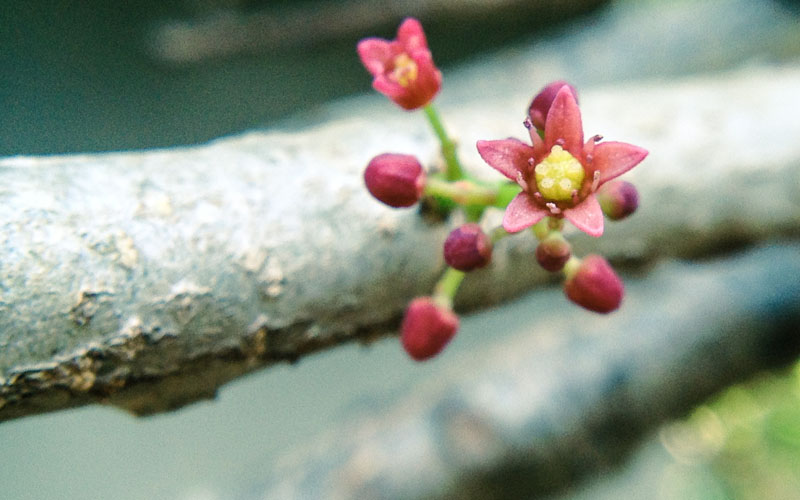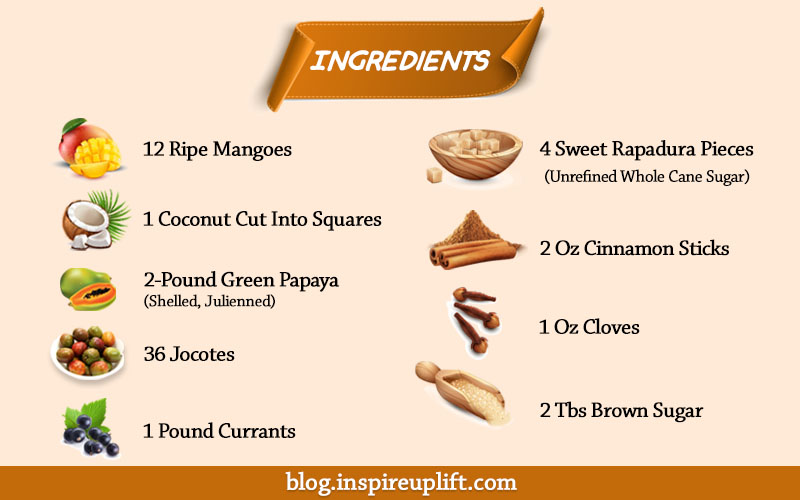There is a fruit that is widely known under the misnomer of plums.
The Spanish plum (or Jocote) – it has nothing to do with the plum’s genus, or family even. Instead, it belongs to the mango family.
But still,
Such fruits are becoming common in the United States too. So, keeping aside the name ambiguity, we have decided to provide you an insight into this fruit.
So, let’s begin.
Table of Contents
1. Jocote is a Popular Central American Fruit
What is Jocote Fruit?

Jocote is drupe fleshy fruit, having a color between red and orange, with a big seed inside having a sweet and sour taste. It’s either consumed fresh, cooked or made sugar syrups out of it.
It belongs to the same family as mangoes and is native to tropical regions of Central America, like Costa Rica, Guatemala, Honduras, El Salvador, and Panama.
It got its name from Nahuatl language’ xocotl,’ which in that language is a scientific classification of the sour fruits.
Jocote and Ciruela are its Spanish names, but what do we call Jocote in English? Well, in English, it’s called Red Mombin, Purple Mombin, or Red Hog plum with a most common name as Spanish Plum.
In Brazil, it’s called seriguela.
What does it look like?

These edible fruits are green that turn to purple-red when ripen, about 4cm long, having waxy skin and size almost equal to a tomato.
The pulp is creamy and turns to yellow when fully ripened with a large stone inside.
It does not produce fertile seeds unless cross-pollinated.
The seed is as big as 60-70% of the entire jocote. So, you’re not getting a whole lot of fruit when you eat it.
The average price is $5 per oz.
2. Jocote tastes like Mango Pudding

A fully ripened jocote tastes a bit like ambarella and mango because all of these belong to one family, Anacardiaceae. On the other hand, green ones are tart.
It also tastes like mango pudding. But whatever view we take, this fruit is citrusy and sweet, that’s for sure.
3. Jocote is Native to Central American Countries
It’s native to the tropical regions of America, stretching from Southern Mexico to northern Peru and parts of north-coastal Brazil.
Specifically naming the countries, we can say its Costa Rica, Nicaragua, Guatemala, El Salvador, and Panama.
How to Eat Jocote Fruit?
Unripe green jocote fruits are eaten with salt and sometimes with peppers as well.
Why? Because salt balances the acidity and tart, which otherwise would taste mouth-puckeringly tart.
The ripened jocotes are eaten like Mango or plum, which means cutting into pieces and discarding the stone inside.
4. Jocote Belongs to the Mango’s Family

5. Jocote Trees are Big
Spanish plum tree is a deciduous tropical tree that reaches up to 9-18 meters height with a trunk of 30-80cm in diameter when fully grown.
Leaves are elliptical-ovate, up to 6cm in length, 1.25cm wide, and fall before the flowering period.
Unlike typical flowers with petals and thin stem, jocote flowers are pinkish red with five widely-spaced petals when bloom, and are directly attached to the thick stems with thick petioles.
It produces male, female and bisexual flowers.

6. Jocote is a Rich source of Vitamin A, C, and B-complex
Nutritional Value

- A 3.5-ounce serving will have 75 calories and 20g carbs
- High levels of antioxidants
- A rich source of vitamin A and C
- It contains carotene, B-complex vitamins, and many amino acids
Further breakdown of its nutritional value can be seen in the following table.
| 100g of Spanish Plum has: | |
| Moisture | 65-86 g |
| Protein | 0.096-0.261 g |
| Fat | 0.03-0.17 g |
| Fiber | 0.2-0.6 g |
| Calcium | 6-24 mg |
| Phosphorus | 32-56 mg |
| Iron | 0.09-1.22 mg |
| Ascorbic Acid | 26-73 mg |
7. Spondias Purpurea Has Amazing Health Benefits
i. As an Antispasmodic

The vitamins, potassium, and calcium in Spanish plum help to get relief from spasm. Spasm is the sudden involuntary contraction of muscles that do not harm but is painful.
ii. Rich in Antioxidants
The high amount of antioxidants in this fruit helps our cells fight against free radicals in the body that otherwise would cause chronic health problems, such as early aging, inflammation, and cardiovascular diseases.
Other sources of high antioxidants may include consuming purple tea as well.
iii. Rich in Iron

Jocots are rich in iron as well, which help our body preserve its vital functions, including the immune system, body temperature maintenance, gastrointestinal processes, energy, and focus.
Also, it helps to fight against anemia.
iv. Energetic

Keeping vigilant by drinking any herbal tea is one thing, getting energy to enhance your capacity is another. The latter can be obtained from fruits as well. Since jocote is rich in carbs and iron, it’s a great source of energy.
v. Improves Digestion & Helpful in Weight Loss

It contains 0.2-0.6g fiber and 76 calories per 100 grams, which helps delay the appetite, and thus improves the digestion and reduces the weight.
8. Jaocote is also used for Medicinal Purposes
The primary use of this delicious creamy fruit is the same as other fruits have, that is, making sweets, desserts, jams, juices, icecreams, etc.
However, its leaves and barks are helpful too. Few of medicinal and other uses are described below:
Medicinal use
- In Mexico, this fruit is used as a diuretic (causing increased passing of urine) and antispasmodic (sudden muscular contraction, for which massager is used).
- Its fruit is decocted to bathe wounds and heal mouth sores.
- Its syrup is used to overcome chronic diarrhea.
- Its barks are decocted to treat mange, ulcers, and bloating caused by intestinal gas.
- Aqueous extract of the leaves has antibacterial properties.
- The gum-resin of the tree is blended with pineapple to treat jaundice.
Other Uses
- Jocote tree exudes a gum that’s used to make glue.
- Its wood is light-weight, which is used as paper pulp and soaps.
9. Jocote’s Most Famous Recipe is Nicaraguan Almibar
Nicaraguan Almibar

One of the popular recipes that include Jocote fruit is Nicaraguan Almibar. It’s a kind of fruit syrup that we usually make from mangoes.
What is curbasá or Nicaraguan Almibar?
Traditionally called Curbasa, this Almibar holds its name in the history of Nicaragua for long. It is specially made on Easters.
A famous Nicaraguan politician, Jaime Wheelock Román, describes in his book, ‘La Comida Nicaragüense’ (The Nicaraguan Food) that Indians who settled there has a different concept of desserts, so a mixed culture resulted in a sweet that is called Curbasa.
Let’s learn how to make this traditional sweet.
Ingredients

Methods
Separately boil jocote, currants, and papaya. Do not mix even after boiling. For jocote, remove from the stove before they sponge, but for currants, let them become soft, and for papaya, boil it until they remain al dente (still firm when bitten). Once done, drain their water and reserve separately.
Tip 1 – Wash the fruits well, preferably in some colander bowl, before use.
Tip 2 – If you want to put fruits in a refrigerator, use antibacterial mats.
Now boil cinnamon and cloves in 2 liters of water. When it releases aroma, add the rapadura pieces and immediately after it melts, add mangoes and coconut and let them boil for 15 minutes further.
In the above solution, add already boiled jocote, currants, and papaya, add the sugar and boil it further for 20 minutes.
Now, lower the flame and let them boil.
Note that while it boils, don’t forget to stir the fruits to prevent it from sticking to the bottom of the pan.
The simmering time should last for 5-6 hours or until the color becomes red wine, and the sugar syrup becomes thick.
And that’s it!
Conclusion
Reddish to orange-yellow, jocote, or Spanish plum is a fruit that you must try. From Central American countries, it has spread to Mexico and the United States as well, where you may find it in the frozen section of the grocery stores as well.
Apart from being eaten as other fruits, it’s medicinal uses are popular as well.
Share your reviews of this fruit if you have tried it yet.

